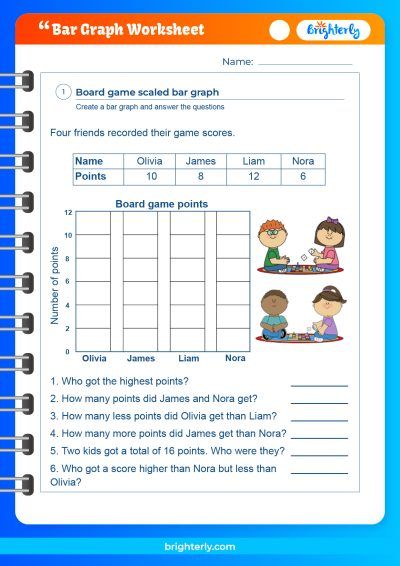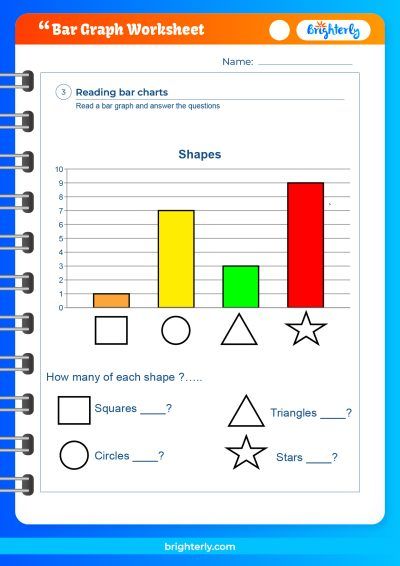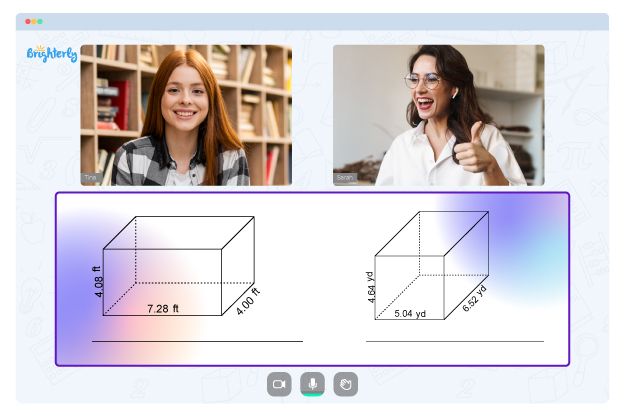Bar Graph – Definition with Examples
Updated on January 9, 2024
At Brighterly, we believe that visualizing data is crucial for fostering a love for mathematics and promoting a deep understanding of various concepts. One of the most effective ways to visualize data for children is by using bar graphs. In this comprehensive guide, we’ll dive into the fascinating world of bar graphs, exploring their properties, elements, and types, as well as providing step-by-step instructions on creating them. By the end of this article, you’ll be well-equipped to teach your child the art of using bar graphs effectively, and together, you can practice solving problems that solidify their understanding. So, without further ado, let’s embark on this exciting journey into the realm of bar graphs!
What is a Bar Graph?
A bar graph, sometimes referred to as a bar chart or bar diagram, is a visual tool that represents data using rectangular bars. These bars can be arranged vertically or horizontally, and their length corresponds to the quantity or frequency of a particular category. Bar graphs are especially helpful when comparing discrete categories and are widely used in mathematics and statistics to simplify the interpretation of data. At Brighterly, we recognize the value of bar graphs as an essential learning tool, enabling children to develop their analytical skills while enjoying a visual and engaging representation of information.
Properties of a Bar Graph
Bar graphs possess several key properties that make them an ideal choice for visualizing data:
- They display data using rectangular bars, making the information easy to digest.
- The length of each bar signifies the quantity or frequency of a specific category, providing a clear visual comparison.
- Bar graphs can be plotted vertically or horizontally, allowing flexibility in presentation.
- They are particularly suitable for comparing discrete categories, simplifying complex data sets.
- Bar graphs effectively transform data into an easily understandable format, facilitating learning and exploration.
Elements of a Bar Graph
A well-designed bar graph consists of several elements that enhance its readability and effectiveness:
- Title: A concise, descriptive title that summarizes the data being represented, setting the context for the viewer.
- Axes: Horizontal and vertical lines that outline the graph area. Typically, the horizontal axis represents categories, while the vertical axis represents values or frequencies.
- Bars: Rectangular bars that symbolize data points. The length of each bar corresponds to the value or frequency of the associated category, providing a visual representation of the data.
- Labels: Text labels that identify the categories and offer information about the values or frequencies of each bar, ensuring clarity and comprehension.
- Scale: A series of evenly spaced values along the vertical axis that help users gauge the relative lengths of the bars, enabling accurate comparisons.
To deepen your understanding of the concept of Bar Graphs, we recommend exploring the array of math worksheets provided by Brighterly. These worksheets are created to aid in your learning and reinforcement of knowledge related to Bar Graphs.
Types of Bar Graphs
There are four primary types of bar graphs, each with its unique application:
Vertical Bar Graphs
In a vertical bar graph, the bars are arranged vertically, with categories displayed along the horizontal axis and values or frequencies along the vertical axis. Vertical bar graphs are particularly suited for comparing categories with a limited number of data points.
Horizontal Bar Graphs
A horizontal bar graph features bars plotted horizontally, with categories positioned along the vertical axis and values or frequencies along the horizontal axis. Horizontal bar graphs excel at comparing categories with numerous data points or presenting data with extensive category labels.
Grouped Bar Graph
A grouped bar graph enables the comparison of multiple data sets within identical categories. In this graph type, bars are clustered by category, with each data set represented by a distinct color or pattern.
Stacked Bar Graph
A stacked bar graph showcases the cumulative values of multiple data sets within the same categories. In this graph, each bar is divided into segments that represent different data sets. The segments are stacked atop one another to display the total value for each category, facilitating an understanding of the overall distribution of data.
How to make a Bar Graph?
- Collect and organize your data.
- Choose the type of bar graph you want to create (vertical, horizontal, grouped, or stacked).
- Determine the scale for the vertical axis.
- Label the horizontal axis with category names and the vertical axis with values or frequencies.
- Draw the bars according to the data, making sure they are proportional to the values or frequencies they represent.
- Add a title, labels, and any additional information to help readers understand the graph.
Bar Graph vs Histogram
While both bar graphs and histograms use rectangular bars to display data, they have different purposes and are used for different types of data. A bar graph is used to compare discrete categories, whereas a histogram is used to display the distribution of continuous data in intervals or bins. In a histogram, the bars are adjacent, with no gaps between them, since the data is continuous. In a bar graph, there are gaps between the bars to represent the discrete nature of the categories.
Solved Examples on Bar Graph
Example 1: Suppose a school conducted a survey to find the favorite fruits of its students. The results are as follows:
- Apples: 20 students
- Bananas: 15 students
- Grapes: 10 students
- Oranges: 25 students
To create a vertical bar graph for this data:
- Label the horizontal axis with the fruit names and the vertical axis with the number of students.
- Draw the bars for each fruit, making sure they are proportional to the number of students who chose each fruit as their favorite.
- Add a title, such as “Favorite Fruits of Students,” and include any necessary labels.
Example 2: A company wants to display its annual sales for the past five years. The sales data is as follows:
- 2018: $500,000
- 2019: $600,000
- 2020: $550,000
- 2021: $700,000
- 2022: $750,000
To create a horizontal bar graph for this data:
- Label the vertical axis with the years and the horizontal axis with the sales amounts.
- Draw the bars for each year, making sure they are proportional to the sales amounts for that year.
- Add a title, such as “Annual Sales (2018-2022),” and include any necessary labels.
Practice Problems on Bar Graph
-
Create a bar graph to represent the number of pets owned by students in a class. The data is as follows:
- Dogs: 12 students
- Cats: 8 students
- Fish: 5 students
- Birds: 3 students
- No pets: 7 students
-
Create a grouped bar graph to compare the number of books read by boys and girls in a class. The data is as follows:
- Fiction: 10 boys, 12 girls
- Nonfiction: 5 boys, 4 girls
- Biographies: 3 boys, 6 girls
- Graphic novels: 8 boys, 2 girls
Conclusion
Bar graphs are an incredibly powerful tool for presenting and comparing data in an easily understandable and visually appealing format. They play a vital role in representing discrete categories and can be adapted to various types, including vertical, horizontal, grouped, and stacked. By mastering the properties, elements, and types of bar graphs, you can empower your child with the knowledge and skills needed to effectively use them to analyze and interpret data. At Brighterly, our goal is to make learning fun and engaging, and we hope this comprehensive guide has inspired you and your child to explore the fascinating world of bar graphs further. Together, you can practice solving problems and unlock the full potential of this versatile data visualization tool.
Frequently Asked Questions on Bar Graph
What is the main purpose of a bar graph?
The main purpose of a bar graph is to display and compare data using rectangular bars, making it easy for people to understand the relationships between different categories.
When should I use a horizontal bar graph instead of a vertical bar graph?
You should use a horizontal bar graph when you have many data points or long category labels, as it provides more space for the labels and makes it easier to read.
Can I use a bar graph to display continuous data?
Bar graphs are not suitable for continuous data. Instead, use a histogram to display the distribution of continuous data in intervals or bins.






